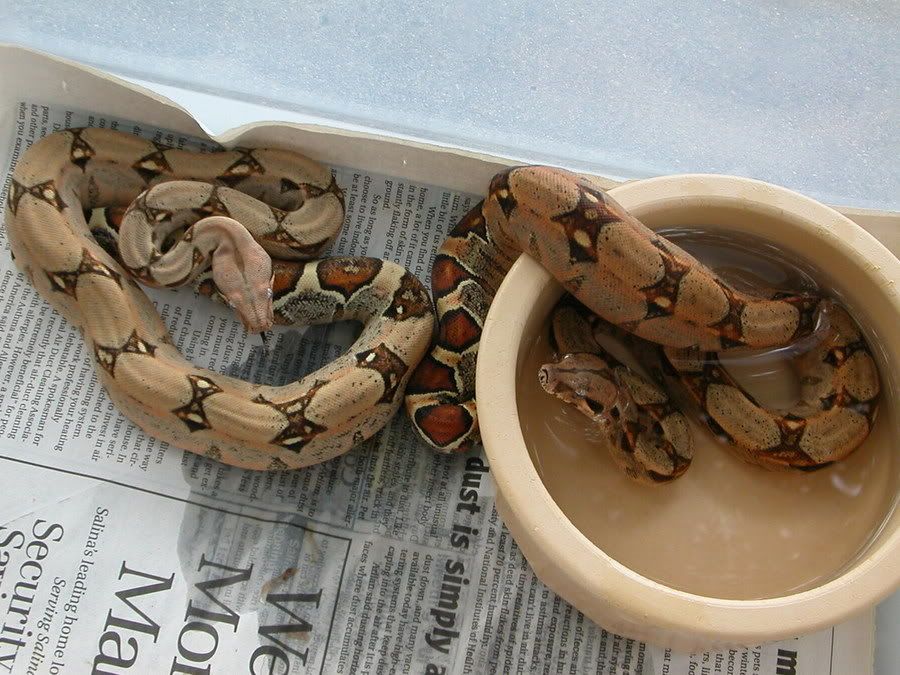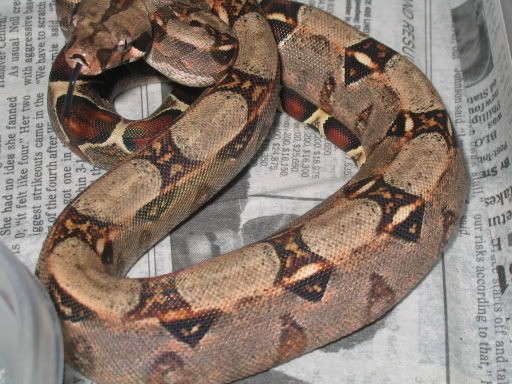Posted by:
boaphile
at Thu Jul 13 09:29:15 2006 [ Email Message ] [ Show All Posts by boaphile ]
Ok, this is it:
First and foremost: This only works very reliably with babies. The younger the animal the more likely it is to be accurate. For whatever reason, the trait I look for becomes less obvious with age. So people with older or larger animals, may of may not observe anything.
Second: The trait I look for is a matter of degrees. Taking one isolated animal and trying to determine if it is or is not a het is not as accurate as it would be to look at all the non-Albino possible het siblings in a litter together. Sometimes individuals can very obviously appear to be a het. I have seen many of them. Sometimes it is more subtle and requires the measurement and comparison of the other babies within the litter. It is a matter of degrees. This cannot be overstated.
Finally, I guess I have been blessed to be observant and logical. Of all the several things I have been fortunate to stumble upon regarding Boa Constrictor breeding, behavior and then this alleged het identification, I have never set out to figure out. I didn't look at litters of possible hets looking for a "marker". I had not even heard of a "marker" until some time after I found it in litters of possible hets. It was a number of years ago that I found it. It was about four years ago that I came out in public saying I had this theory. I came under some criticism at the time just as I had after I wrote the Boa breeding article in 1996 that described how I breed my Boas and that the gestation period can be known etc... I guess it comes with the territory. I have always tried to share what I have learned regardless of the fact that many didn't believe. But that's ok. Nobody argues the length of the gestation period in Boas any more. Although not all Boas have read what I have written, most comply and cooperate delivering those puppies around 105 days after the Post Ovulation Shed. Not all but most. I have to write another chapter in the book to cover those non-compliant animals... LOL
All that being said, I have nothing monetarily to gain telling this theory. The same as I had nothing to gain telling the truth about how the Pastel trait works in Boas. In fact in that case the exact opposite is true. Still, I think the information is accurate and something that will help in the understanding in general of Boas Constrictor genetics and the possibilities that we have just scratched the surface of. So here goes.
When I first posted that I had a theory on this, there were many others who speculated on everything but the thing I had observed. Now some of the other things folks have speculated may very well also be "markers" of hets. I have only keyed in on one thing that has proven pretty stinking accurate for me. I have not looked at any of those other things at all. Now several years after I wrote that I had a theory, many others have begun to notice the same thing I observed. This will simply offer confirmation to those folks.
I was looking at a litter of 66% possible hets. Then I noticed something interesting. Hmmm. I continued to look. Wow! A bunch of these babies had something literally staring me in the face. A smaller number didn't have it but a bunch did. I have made a lot of 66% possible het for Albino babies. A lot. I began looking at others and some had it while others didn't. "I might be onto something here", I thought.
After I found the little "marker" I thought about it. If Albino Boas lack all black pigment, how could this be expressed in a het? What could happen that would might "bleed over" into animals that are het for Albino? Well, Albinos lack all Black pigment. So maybe, just maybe hets lacked some of that black pigment. So how could this be identified? Well for one, any Boa that lacks some pigment could be arguably a little prettier than animals that don't lack any normal black pigment. The reduction in black would make the animals more likely to reveal hidden beauty in the form of greater color as well. One other thing I have noticed, by the way, is known hets on average and Albinos, again on average, have narrower saddles than other Boas. This is not always the case but on average this is the case. So people producing possible hets, assuming they don't keep all the babies, are most likely to keep the prettiest babies right? So most people keeping possible hets in hopes that they are in fact hets, would most often be successful in producing Albinos from those possible hets.
Again remember, I did not set out to figure this out. I spotted something and then tried to think logically how what I was seeing could in fact be a "marker". So I have prolonged the agony long enough haven't I? Here are a couple photos I found on line that I am using here without permission, but I'm sure they won't mind:
These are Linda's, at least to me, very obvious hets:

Here's another with her sister, Jazz.

These are going to make GREAT Albinos too! Look at the color of these girls! Nice!
This is one of Spangler's Serpents:

The eyes have it. It's in the eyes. I noticed babies that looked like they had a tiny light bulb inside their heads illuminating the eyes. You often see this same thing in Hypos. The top part of the eye in most Boas is about the same color as the skin immediately adjacent to the eye. In the case of hets, or so goes my theory, the top of the eye is lighter or brighter than that skin adjacent to it. The irregular muddying around the eye should be discounted and only the normal skin color at the top of the eye should be considered. Some Motleys and Hypos seem to be prone to this muddying of some scales on the top of the head next to or near they eye so don't compare to that. This is the "marker". Pretty simple really. But, just to reiterate. Look back at my first two points at the top of the post. Individuals can be identified sometimes. Just because an animal you have does not show this difference now, does not mean that it didn't when it was a little baby. So don't give up on those possible hets you are raising. It is a matter of degrees and given the fact that many will not have the entire litter to compare to, most will not get much satisfaction from knowing this information. When you produce your own possible hets, this will give you greater direction in what animals to keep. I wish it was something that stayed with them throughout life but it is not. This is all I have stumbled upon regarding this topic.
I don't see why this shouldn't also work for Hypos possible het or anything else possible het for albino either. This method may of may not work with other types of Albinos and even other species. Someone else is going to have to figure out if that is the case though. Don't look for me to get any Ball Pythons any time soon...
So all that being said, Albinism is a simple recessive trait right? Well is it really? A simple recessive trait does not exhibit that trait in the heterozygous form. If I am correct and there is at least this one marker for het for Albino animals, doesn't that really make Albinism, at least the Kahl strain of Albinism in Boa Constrictors an "incomplete co-dominant" trait? Now that is sure to stir a little controversy but I'm used to that...
This knowledge has meant one thing for me. That is, I do not sell animals that I do not believe are hets as possible hets if I have sorted through them. The 66% possible hets I have sold, and sorted though, have all been animals I believe were in fact hets. The non-hets have just been sold as regular Boas. It isn't fair to sort through them and then sell the picked over animals as possible hets if they likely aren't. I certainly don't think anyone should use this method to sell possible hets as hets. I don't think this will prove to be 100% accurate. Just as identifying Pastel Boas, there is subjectivity to this as well. It has proven to be very accurate for me but nobody should ever use this to sell an animal as a het that is in fact only a possible het until proven by breeding trial to be otherwise.
Now how about those het for Anerys? What is the marker for them? I have no idea... I do have an animal I am hoping is het for Leucistic though... LOL Oh and for those who have followed my own little forum, my "Polka Dot" male is a het too, or so I theorize...
[ Show Entire Thread ]
|





